Liquid Crystal Alignment Agent, Liquid Crystal Alignment Film, And Liquid Crystal Display Element And Method Of Manufacturing The Same
A liquid crystal alignment agent and a technology for liquid crystal alignment, applied in the directions of liquid crystal materials, chemical instruments and methods, optics, etc., can solve the problems of inability to obtain a uniform and good liquid crystal alignment film, uneven film spread of the alignment agent, and poor solubility, and achieve excellent Effect of display quality, improved coatability, good pretilt angle stability
- Summary
- Abstract
- Description
- Claims
- Application Information
AI Technical Summary
Problems solved by technology
Method used
Image
Examples
Synthetic example 1 and
[0078] Synthesis Example 1 and Synthesis Example 2
[0079] Add diamine and tetracarboxylic dianhydride to N-methyl-2-pyrrolidone in sequence (its chemical structure and weight are shown in Table 1 and Table 3) to prepare a solution with a solid content of 20% by weight, and in React at 40°C to 60°C for 4 hours to 6 hours to obtain a polyamic acid polymer, and then purify it with a solvent (such as methanol or water) with poor solubility for the polyamic acid polymer, and by reducing Drying under pressure gave Polymer A1 and Polymer A2.
Synthetic example 3 and
[0080] Synthesis Example 3 and Synthesis Example 4
[0081] Add diamine and tetracarboxylic dianhydride to N-isopropyl-2-pyrrolidone in sequence (its chemical structure and weight are shown in Table 1 and Table 3) to prepare a solution with a solid content of 20% by weight, and React at 40°C to 60°C for 4 hours to 6 hours to obtain a polyamic acid polymer, and then purify it with a solvent (such as methanol or water) that has poor solubility for the polyamic acid polymer, and by reducing Drying under pressure gave Polymer A3 and Polymer A4.
Synthetic example 5
[0083] Sequentially add diamine and tetracarboxylic dianhydride to N-methyl-2-pyrrolidone (as shown in Table 3) to prepare a solution with a solid content of 20% by weight, and store at 40°C to 60°C React for 4 hours to 6 hours to obtain a polyamic acid polymer, then add pyridine and acetic anhydride to the obtained polyamic acid polymer (the amount depends on the polyimidization ratio), at 100°C to 110°C The dehydration / ring-closing reaction was carried out at C for 3 hours to 4 hours, and the resulting solution was precipitated with methanol, purified with methanol, and finally collected and dried under reduced pressure to obtain polymer B1.
PUM
| Property | Measurement | Unit |
|---|---|---|
| thickness | aaaaa | aaaaa |
Abstract
Description
Claims
Application Information
 Login to View More
Login to View More - R&D
- Intellectual Property
- Life Sciences
- Materials
- Tech Scout
- Unparalleled Data Quality
- Higher Quality Content
- 60% Fewer Hallucinations
Browse by: Latest US Patents, China's latest patents, Technical Efficacy Thesaurus, Application Domain, Technology Topic, Popular Technical Reports.
© 2025 PatSnap. All rights reserved.Legal|Privacy policy|Modern Slavery Act Transparency Statement|Sitemap|About US| Contact US: help@patsnap.com



